Page 120 of 276
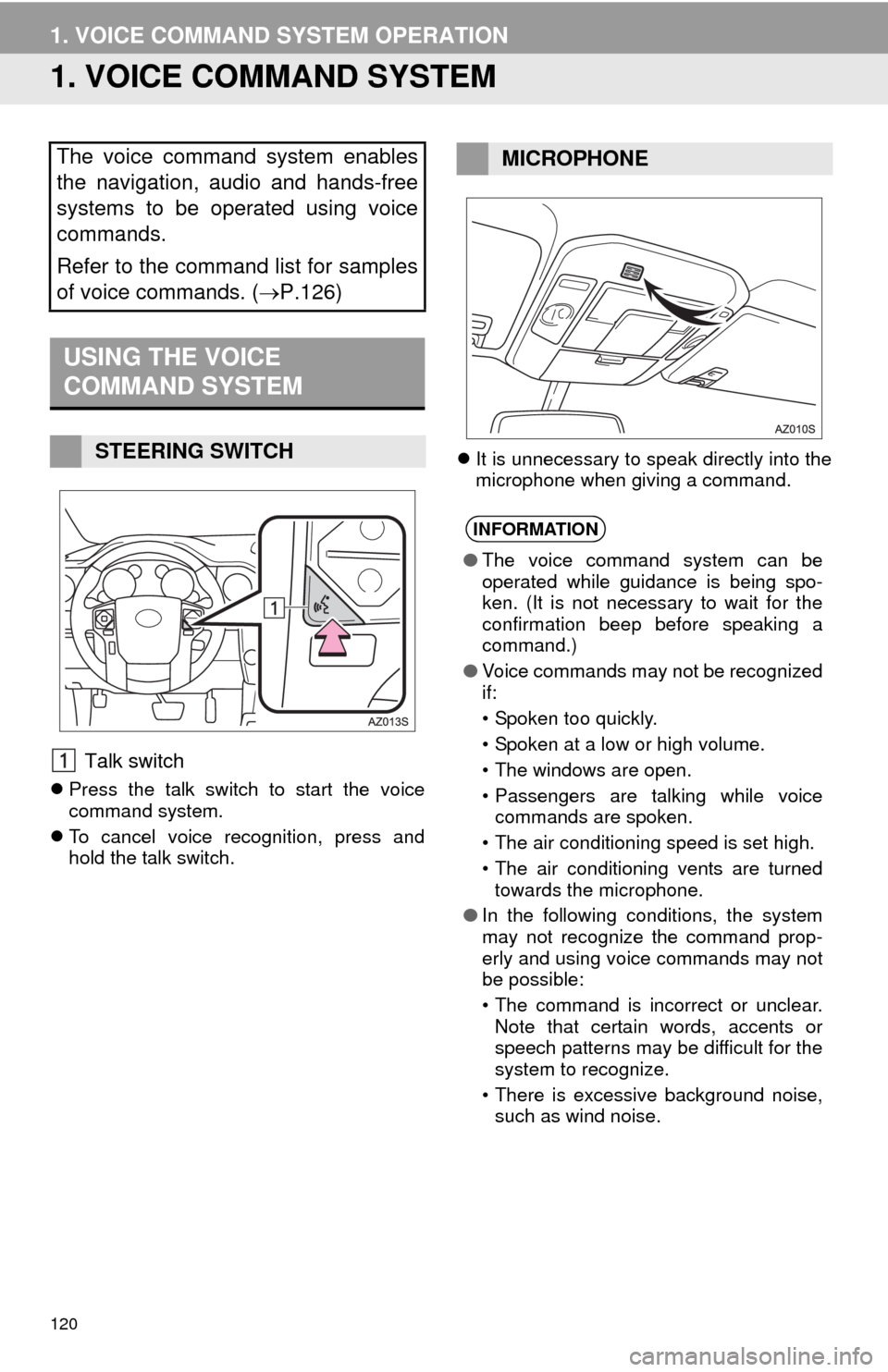
120
1. VOICE COMMAND SYSTEM OPERATION
1. VOICE COMMAND SYSTEM
Talk switch
Press the talk switch to start the voice
command system.
To cancel voice recognition, press and
hold the talk switch.It is unnecessary to speak directly into the
microphone when giving a command.
The voice command system enables
the navigation, audio and hands-free
systems to be operated using voice
commands.
Refer to the command list for samples
of voice commands. (P.126)
USING THE VOICE
COMMAND SYSTEM
STEERING SWITCH
MICROPHONE
INFORMATION
●The voice command system can be
operated while guidance is being spo-
ken. (It is not necessary to wait for the
confirmation beep before speaking a
command.)
●Voice commands may not be recognized
if:
• Spoken too quickly.
• Spoken at a low or high volume.
• The windows are open.
• Passengers are talking while voice
commands are spoken.
• The air conditioning speed is set high.
• The air conditioning vents are turned
towards the microphone.
●In the following conditions, the system
may not recognize the command prop-
erly and using voice commands may not
be possible:
• The command is incorrect or unclear.
Note that certain words, accents or
speech patterns may be difficult for the
system to recognize.
• There is excessive background noise,
such as wind noise.
Page 126 of 276
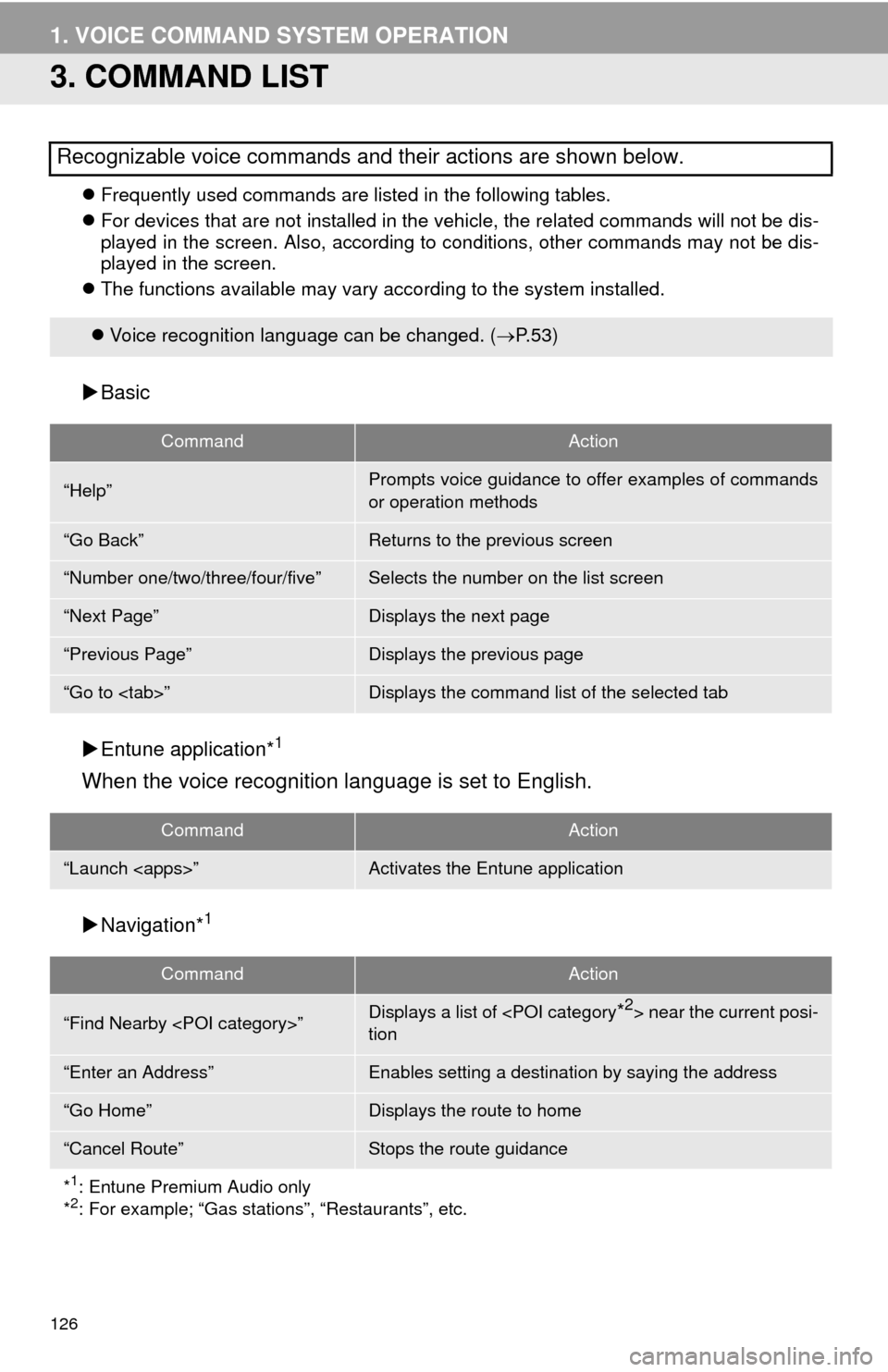
126
1. VOICE COMMAND SYSTEM OPERATION
3. COMMAND LIST
Frequently used commands are listed in the following tables.
For devices that are not installed in the vehicle, the related commands will not be dis-
played in the screen. Also, according to conditions, other commands may not be dis-
played in the screen.
The functions available may vary according to the system installed.
Basic
Entune application*
1
When the voice recognition language is set to English.
Navigation*1
Recognizable voice commands and their actions are shown below.
Voice recognition language can be changed. (P.53)
CommandAction
“Help”Prompts voice guidance to offer examples of commands
or operation methods
“Go Back”Returns to the previous screen
“Number one/two/three/four/five”Selects the number on the list screen
“Next Page”Displays the next page
“Previous Page”Displays the previous page
“Go to ”Displays the command list of the selected tab
CommandAction
“Launch ”Activates the Entune application
CommandAction
“Find Nearby ”Displays a list of near the current posi-
tion
“Enter an Address”Enables setting a destination by saying the address
“Go Home”Displays the route to home
“Cancel Route”Stops the route guidance
*
1: Entune Premium Audio only
*2: For example; “Gas stations”, “Restaurants”, etc.
Page 160 of 276
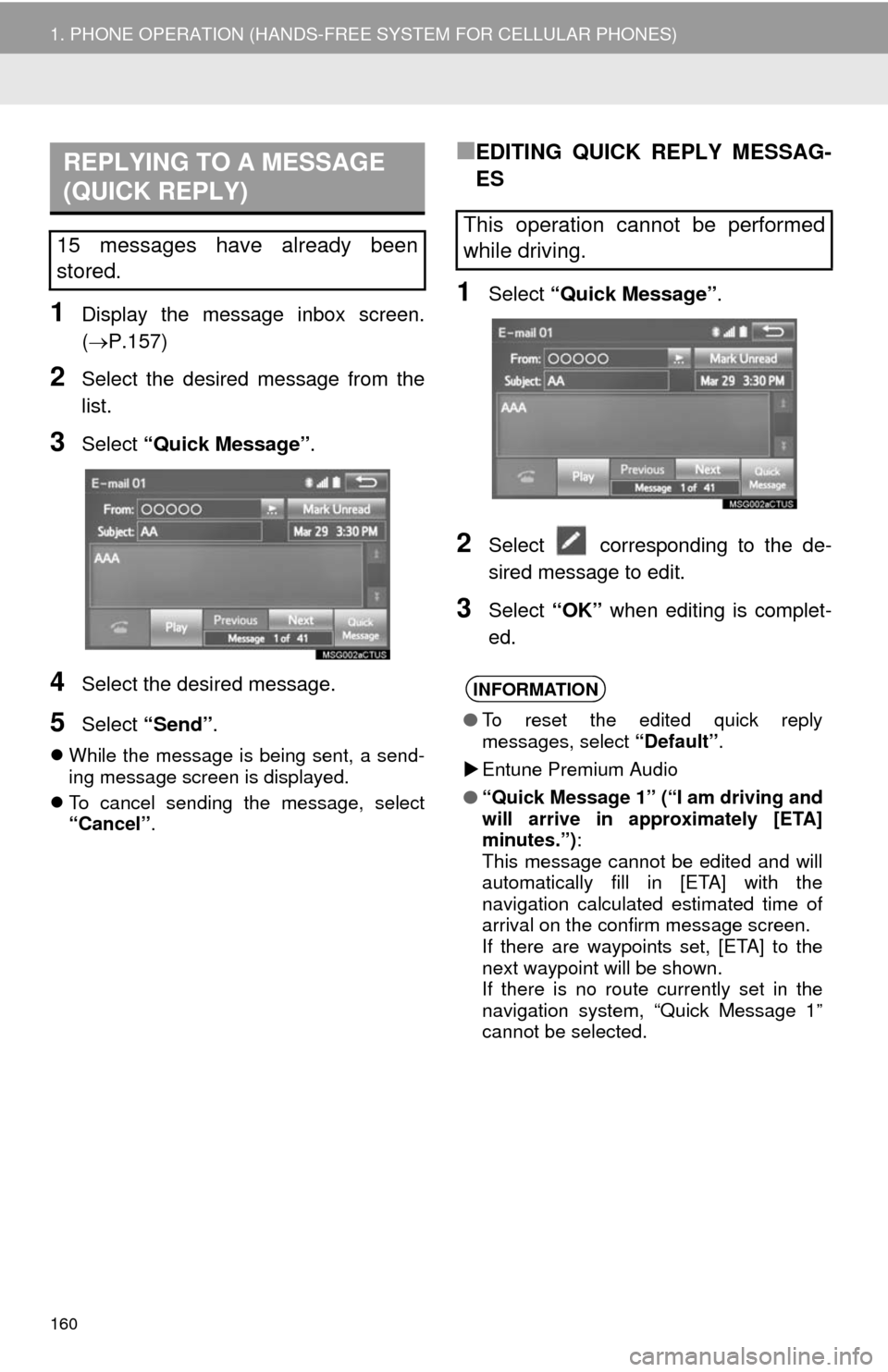
160
1. PHONE OPERATION (HANDS-FREE SYSTEM FOR CELLULAR PHONES)
1Display the message inbox screen.
(P.157)
2Select the desired message from the
list.
3Select “Quick Message”.
4Select the desired message.
5Select “Send”.
While the message is being sent, a send-
ing message screen is displayed.
To cancel sending the message, select
“Cancel”.
■EDITING QUICK REPLY MESSAG-
ES
1Select “Quick Message”.
2Select corresponding to the de-
sired message to edit.
3Select “OK” when editing is complet-
ed.
REPLYING TO A MESSAGE
(QUICK REPLY)
15 messages have already been
stored.This operation cannot be performed
while driving.
INFORMATION
●To reset the edited quick reply
messages, select “Default”.
Entune Premium Audio
●“Quick Message 1” (“I am driving and
will arrive in approximately [ETA]
minutes.”):
This message cannot be edited and will
automatically fill in [ETA] with the
navigation calculated estimated time of
arrival on the confirm message screen.
If there are waypoints set, [ETA] to the
next waypoint will be shown.
If there is no route currently set in the
navigation system, “Quick Message 1”
cannot be selected.
Page 180 of 276
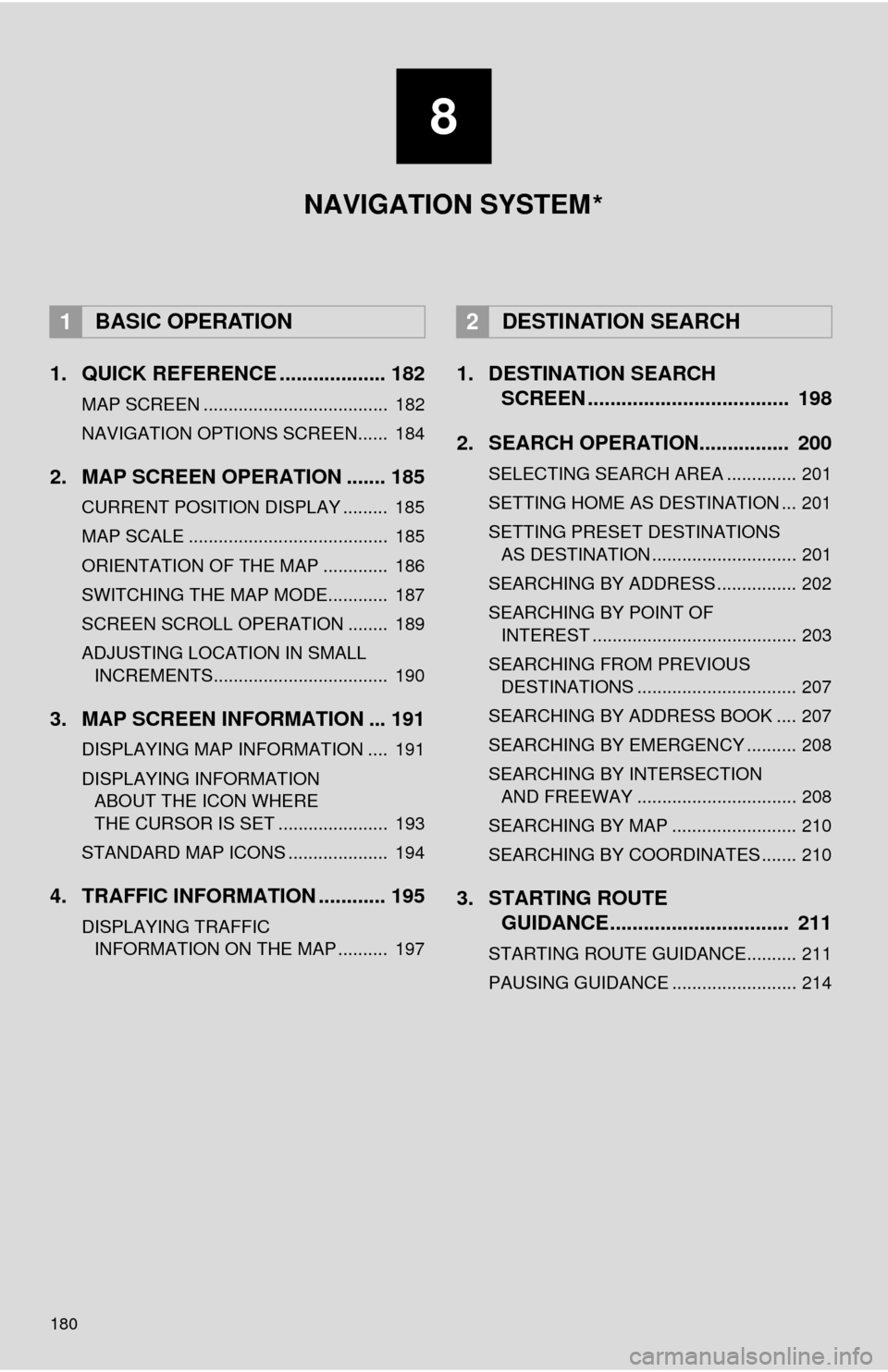
180
1. QUICK REFERENCE ................... 182
MAP SCREEN ..................................... 182
NAVIGATION OPTIONS SCREEN...... 184
2. MAP SCREEN OPERATION ....... 185
CURRENT POSITION DISPLAY ......... 185
MAP SCALE ........................................ 185
ORIENTATION OF THE MAP ............. 186
SWITCHING THE MAP MODE............ 187
SCREEN SCROLL OPERATION ........ 189
ADJUSTING LOCATION IN SMALL INCREMENTS................................... 190
3. MAP SCREEN INFORMATION ... 191
DISPLAYING MAP INFORMATION .... 191
DISPLAYING INFORMATION ABOUT THE ICON WHERE
THE CURSOR IS SET ...................... 193
STANDARD MAP ICONS .................... 194
4. TRAFFIC INFORMATION ............ 195
DISPLAYING TRAFFIC INFORMATION ON THE MAP .......... 197
1. DESTINATION SEARCH SCREEN .................................... 198
2. SEARCH OPERATION.. .............. 200
SELECTING SEARCH AREA .............. 201
SETTING HOME AS DESTINATION ... 201
SETTING PRESET DESTINATIONS
AS DESTINATION ............................. 201
SEARCHING BY ADDRESS ................ 202
SEARCHING BY POINT OF INTEREST ......................................... 203
SEARCHING FROM PREVIOUS DESTINATIONS ................................ 207
SEARCHING BY ADDRESS BOOK .... 207
SEARCHING BY EMERGENCY .......... 208
SEARCHING BY INTERSECTION AND FREEWAY ................................ 208
SEARCHING BY MAP ......................... 210
SEARCHING BY COORDINATES ....... 210
3. STARTING ROUTE GUIDANCE ....... ......................... 211
STARTING ROUTE GUIDANCE.......... 211
PAUSING GUIDANCE ......................... 214
1BASIC OPERATION2DESTINATION SEARCH
8
NAVIGATION SYSTEM
*
Page 181 of 276
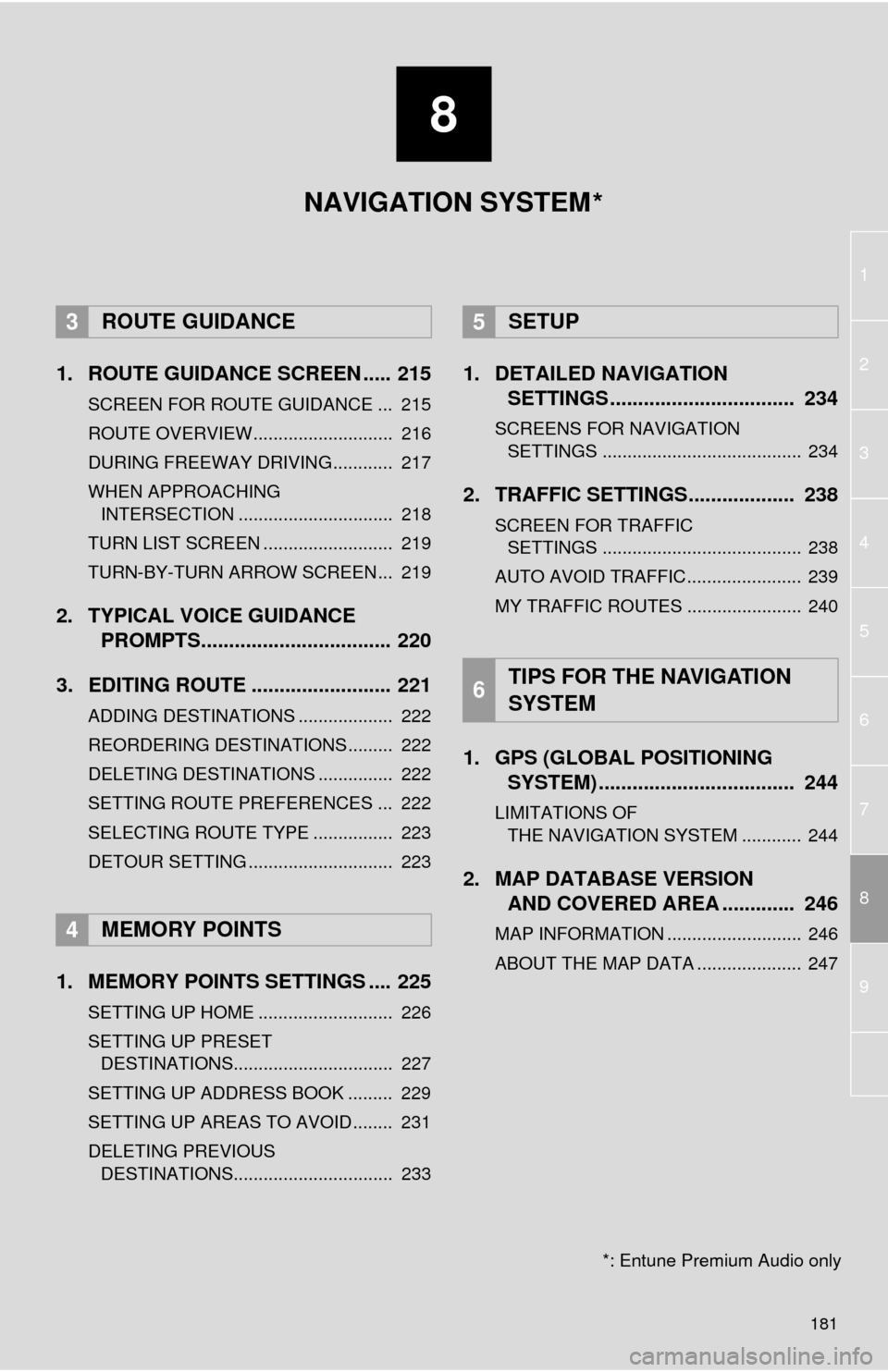
8
181
1
2
8
4
5
6
7
3
9
1. ROUTE GUIDANCE SCREEN ..... 215
SCREEN FOR ROUTE GUIDANCE ... 215
ROUTE OVERVIEW............................ 216
DURING FREEWAY DRIVING............ 217
WHEN APPROACHING INTERSECTION ............................... 218
TURN LIST SCREEN .......................... 219
TURN-BY-TURN ARROW SCREEN ... 219
2. TYPICAL VOICE GUIDANCE PROMPTS.................................. 220
3. EDITING ROUTE ......................... 221
ADDING DESTINATIONS ................... 222
REORDERING DESTINATIONS ......... 222
DELETING DESTINATIONS ............... 222
SETTING ROUTE PREFERENCES ... 222
SELECTING ROUTE TYPE ................ 223
DETOUR SETTING ............................. 223
1. MEMORY POINTS SETTINGS .... 225
SETTING UP HOME ........................... 226
SETTING UP PRESET DESTINATIONS................................ 227
SETTING UP ADDRESS BOOK ......... 229
SETTING UP AREAS TO AVOID ........ 231
DELETING PREVIOUS DESTINATIONS................................ 233
1. DETAILED NAVIGATION SETTINGS ................................. 234
SCREENS FOR NAVIGATION
SETTINGS ........................................ 234
2. TRAFFIC SETTINGS................... 238
SCREEN FOR TRAFFIC SETTINGS ........................................ 238
AUTO AVOID TRAFFIC....................... 239
MY TRAFFIC ROUTES ....................... 240
1. GPS (GLOBAL POSITIONING SYSTEM) .................... ............... 244
LIMITATIONS OF
THE NAVIGATION SYSTEM ............ 244
2. MAP DATABASE VERSION AND COVERED AREA ............. 246
MAP INFORMATION ........................... 246
ABOUT THE MAP DATA ..................... 247
3ROUTE GUIDANCE
4MEMORY POINTS
5SETUP
6TIPS FOR THE NAVIGATION
SYSTEM
NAVIGATION SYSTEM
*: Entune Premium Audio only
*
Page 182 of 276
182
1. BASIC OPERATION
1. QUICK REFERENCE
MAP SCREEN
To display this screen, press the “APPS” button, then select “Navigation” on the
“Apps” screen.
No.NameFunctionPage
2D North-up, 2D
heading-up or 3D
heading-up sym-
bolIndicates whether the map orientation is set to
north-up or heading-up. The letter(s) beside this
symbol indicate the vehicle’s heading direction
(e.g. N for north). In 3D map, only a heading-up
view is available.
186
Options buttonSelect to display the “Navigation Options” screen.184
“GPS” mark
(Global Position-
ing System)Shows that the vehicle is receiving signals from
the GPS.244
Traffic indicator
Shows that traffic information is received. Select
to start voice guidance for traffic information.
When traffic information is received via HD, HD
mark is displayed on the right.
195
Scale indicatorThis figure indicates the map scale.185
Page 183 of 276
183
1. BASIC OPERATION
8
NAVIGATION SYSTEM
Zoom in/out but-
tonSelect to magnify or reduce the map scale. When
either button is selected, the map scale indicator
bar appears at the bottom of the screen.
185
Footprint map
buttonSelect to display the footprint map screen.186
Current position
button/voice
guidance buttonSelect to display the current position address.
Select to repeat voice guidance.185
Destination but-
tonSelect to display the “Destination” screen.198
Route informa-
tion bar
Displays the current street name, or the distance
with the estimated travel time/arrival time to the
destination. The route information bar fills from
left to right as the vehicle progresses on the
route.
215
Route informa-
tion buttonSelect to change the display between the current
street name and the distance with the estimated
travel/arrival time.
216
No.NameFunctionPage
Page 185 of 276
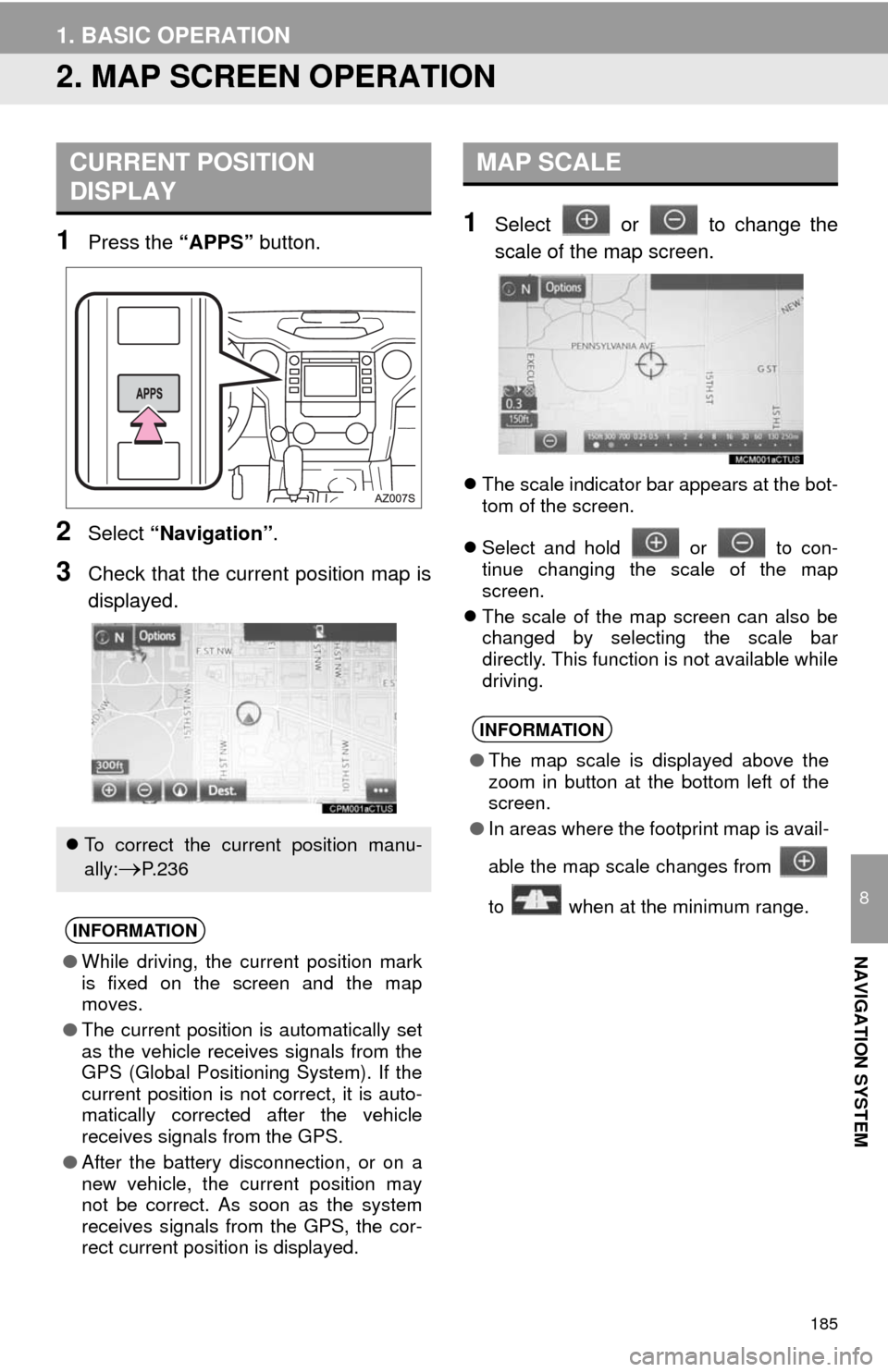
185
1. BASIC OPERATION
8
NAVIGATION SYSTEM
2. MAP SCREEN OPERATION
1Press the “APPS” button.
2Select “Navigation”.
3Check that the current position map is
displayed.
1Select or to change the
scale of the map screen.
The scale indicator bar appears at the bot-
tom of the screen.
Select and hold or to con-
tinue changing the scale of the map
screen.
The scale of the map screen can also be
changed by selecting the scale bar
directly. This function is not available while
driving.
CURRENT POSITION
DISPLAY
To correct the current position manu-
ally:
P. 2 3 6
INFORMATION
●While driving, the current position mark
is fixed on the screen and the map
moves.
●The current position is automatically set
as the vehicle receives signals from the
GPS (Global Positioning System). If the
current position is not correct, it is auto-
matically corrected after the vehicle
receives signals from the GPS.
●After the battery disconnection, or on a
new vehicle, the current position may
not be correct. As soon as the system
receives signals from the GPS, the cor-
rect current position is displayed.
MAP SCALE
INFORMATION
●The map scale is displayed above the
zoom in button at the bottom left of the
screen.
●In areas where the footprint map is avail-
able the map scale changes from
to when at the minimum range.